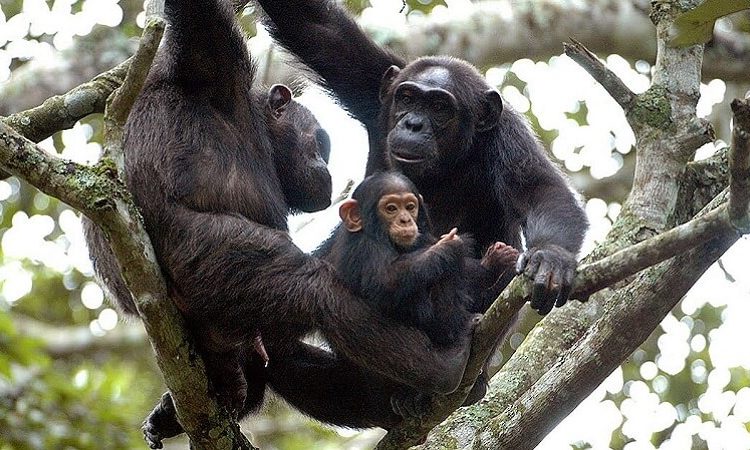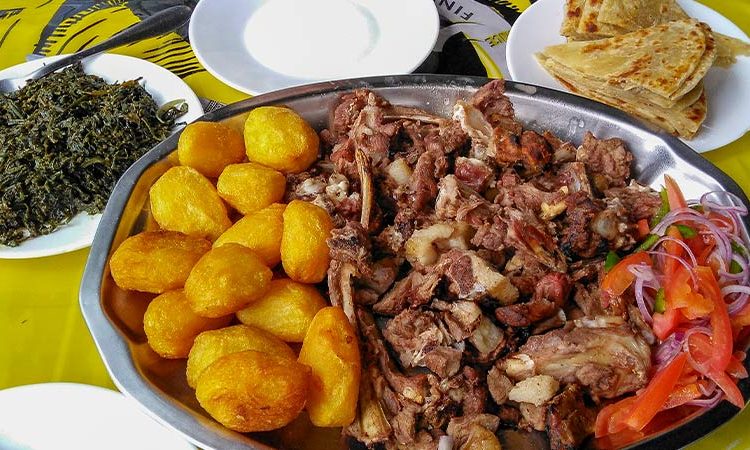- GET IN TOUCH WITH US:
- +256 753518160
- +256 777842166
- info@experiyatourcompany.com

Can I do a canopy walk in Nyungwe Forest?
November 13, 2025
What’s unique about Nyungwe National Park?
November 13, 2025Where Can I See Chimpanzees in Rwanda?
Rwanda is globally celebrated for its mountain gorillas, but beyond the towering volcanoes and thick bamboo forests lies another world of extraordinary primate encounters—chimpanzees. These highly intelligent, social, and expressive primates live in some of Rwanda’s most enchanting natural landscapes, offering travelers a chance to experience wildlife encounters that are both thrilling and deeply emotional. If you’re planning a trip to Rwanda and wondering, Where can I see chimpanzees? the answer is simple: Rwanda is home to two main chimpanzee trekking destinations—Nyungwe Forest National Park and Gishwati-Mukura National Park.
This comprehensive guide explores both destinations in detail, what to expect during a chimpanzee trek, the best time to visit, and why chimpanzee trekking in Rwanda is one of the country’s most rewarding wildlife experiences.
Rwanda: A Hidden Primate Paradise
Rwanda may be small in size, but it is incredibly rich in primate biodiversity. With its misty rainforests, deep valleys, and ancient ecosystems, the country provides ideal habitats for more than 13 primate species, including:
Chimpanzees
Golden monkeys
L’Hoest’s monkeys
Colobus monkeys
Blue monkeys
Baboon species
Chimpanzees are the second-most sought-after primates after gorillas, and trekking them offers a completely different adventure—faster-paced, more vocal, and often more dramatic.
The Best Place to See Chimpanzees in Rwanda: Nyungwe Forest National Park
Nyungwe Forest is Rwanda’s primary and most iconic destination for chimpanzee trekking. Known as one of Africa’s oldest forests, Nyungwe spans more than 1,000 square kilometers and is a sanctuary of biodiversity.
Why Nyungwe Is Rwanda’s Top Chimpanzee Destination
Home to the largest chimpanzee population in the country
Offers daily chimp trekking experiences
Beautiful rainforest setting with rich birdlife and plant species
Multiple trails that enhance the trekking experience
Chance to combine chimp trekking with the famous canopy walk
With roughly 500 chimpanzees, Nyungwe provides a high chance of sightings, though the forest’s thick vegetation and fast movement of chimps make the trek both exciting and unpredictable.
The Uwinka and Cyamudongo Trekking Sectors
Chimpanzee trekking in Nyungwe happens in two main areas:
1. Uwinka Sector
Located near the main park reception, the Uwinka area offers a classic chimp trek. Groups often depart early in the morning—usually around 5:00 AM—to catch the chimps before they move deeper into the forest.
This sector features dense forests, steep trails, and stunning views of the canopy.
2. Cyamudongo Forest
Cyamudongo is a smaller, isolated patch of rainforest located on Nyungwe’s western edge. Although compact, it has a habituated chimp community, making sightings here often more reliable than Uwinka.
Many travelers prefer Cyamudongo because the terrain is slightly easier and the chimps tend to stay within a more accessible area.
What to Expect During a Nyungwe Chimp Trek
Chimpanzee trekking is quite different from gorilla trekking. Chimps move quickly, swing through trees, vocalize loudly, and cover long distances. Your trek will typically involve:
Early morning briefing at 5:00–6:00 AM
A guided hike into dense rainforest
Walking through steep, sometimes slippery terrain
Tracking chimps by sound—pant-hoots, drumming, screaming
Unexpected but thrilling encounters
Once you find the chimps, the experience is incredible. You’ll spend up to one hour observing them:
Grooming one another
Playing in trees
Foraging for fruit
Caring for infants
Vocalizing loudly
The forest echoes with their calls—an unforgettable sound that sends shivers of excitement through any wildlife lover.
Gishwati-Mukura National Park: Rwanda’s Newest Chimpanzee Haven
Gishwati-Mukura, a relatively new national park located in Rwanda’s Northwestern region, is the country’s second chimp trekking destination. Established to protect Rwanda’s diminishing Western rainforests, this park is smaller than Nyungwe but growing in popularity.
Why Visit Gishwati-Mukura for Chimp Trekking?
Less crowded than Nyungwe, offering a more intimate experience
Home to a small but habituated group of chimpanzees
Opportunities to see other primates, like golden monkeys and blue monkeys
Beautiful scenery with streams, thick vegetation, and rolling hills
For travelers who prefer quieter, less-touristic wildlife adventures, Gishwati-Mukura is perfect.
What the Trek Is Like
Chimp trekking here also starts early in the morning. Because the park is smaller, trekking times may be shorter, but the forest trails are rich with biodiversity. Expect:
A peaceful trekking atmosphere
Birdsong and rustling leaves
Occasional sightings of other primates
Close interactions with knowledgeable local guides
The experience feels intimate—almost like walking into a secret primate sanctuary.
Best Time to See Chimpanzees in Rwanda
Chimpanzee trekking is possible year-round in Rwanda, but the experience varies slightly by season.
Dry Seasons (Best Time)
June to September
December to February
During these months:
Trails are less muddy
Visibility is better
Chimps are easier to track
Weather is more comfortable
Wet Seasons (Still Good)
March to May
October to November
These months offer:
Lush, green rainforests
Photogenic misty scenes
More food availability, so chimps stay closer
However, trails can be muddy, and the hike may be more challenging.
Permits for Chimpanzee Trekking in Rwanda
To trek chimpanzees in Rwanda, you must purchase a permit. Rwanda Development Board (RDB) manages all permits.
Chimpanzee permit prices are significantly cheaper than gorilla trekking permits, making them accessible to many travelers.
Booking in advance is highly recommended, especially during peak seasons.
What to Wear During Chimpanzee Trekking
Nyungwe and Gishwati forests can be cold, wet, and muddy. For comfort and safety, pack:
Long-sleeved shirts
Hiking boots
Rain jacket or poncho
Garden gloves (helpful when grabbing vegetation)
Long trousers
Warm layers
A hat or headband
Drinking water
Snacks
A backpack
Avoid bright colors and loud accessories—neutral tones work best.
Difficulty Level of Chimp Trekking
Chimpanzee trekking difficulty varies based on terrain, weather, and chimp movement. Generally:
It ranges from moderate to difficult
Trails can be steep
Chimps move fast, requiring quick maneuvering
Hikers should be reasonably fit
That said, anyone with good mobility and determination can complete the trek.
Other Wildlife You May See During a Chimp Trek
Chimp trekking often leads to many unexpected wildlife encounters. You may see:
Colobus monkeys
Blue monkeys
L’Hoest’s monkeys
Mangabeys
Bushbabies
Vervet monkeys
Antelopes
Dozens of bird species
Nyungwe is one of Africa’s top birding destinations, making every moment a nature lover’s paradise.
Why Chimpanzee Trekking in Rwanda Is Special
Chimp trekking in Rwanda is special for several reasons:
Rwanda offers rare habituated chimp groups
Forests like Nyungwe are ancient and magical
Guides are extremely knowledgeable
The experience feels raw, wild, and authentic
Trekking supports conservation and communities
Seeing chimpanzees in their natural environment is a humbling, emotional experience—one that stays with you forever.
Tips for a Successful Chimp Trek
Book permits early
Wake up early (treks begin pre-dawn)
Bring warm layers—it gets cold
Carry a waterproof bag
Listen to your guide at all times
Stay quiet when near chimps
Respect the one-hour viewing limit
Do not feed wildlife
Keep a safe distance for both your safety and theirs
Patience is essential—finding chimps can take time.
How Long Should You Spend in Rwanda for Chimp Trekking?
To fully enjoy chimp trekking, plan to spend:
1–2 days in Nyungwe for chimp trekking and canopy walk
2–3 days if combining with waterfall hikes or birding
3–5 days if adding Gishwati-Mukura or Lake Kivu experiences
Many travelers combine chimp trekking with gorilla trekking for the ultimate primate safari.
Book Your Chimpanzee Trekking Experience with Experiya Tour Company
For the smoothest, most memorable chimp trekking experience in Rwanda, book your adventure with Experiya Tour Company. Their expert team organizes permits, transportation, guided treks, accommodations, and full itineraries tailored to your interests. Whether you choose Nyungwe, Gishwati-Mukura, or both, Experiya ensures your trek is safe, comfortable, and enriched with local knowledge. From Kigali to the rainforest and back, Experiya Tour Company delivers exceptional primate experiences that bring Rwanda’s wilderness to life.




